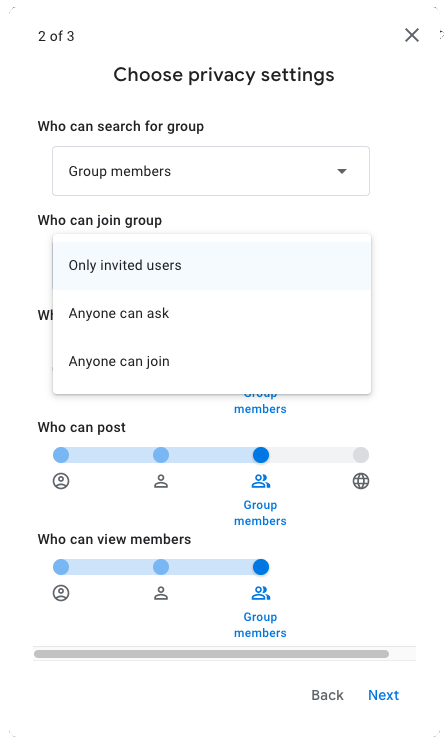3 Team Communication
Your team will need to communicate. There are two main choices to make: how to make announcements and how to have discussions. You will also probably want to set up a range of social media accounts, even if you don’t plan to use them right away.
3.1 Announcements
Email is probably the most common way of making announcements.
It’s almost always preferable to use a managed email list than to send emails to all members individually. (If you must do the latter at the start; please blind CC emails to avoid a reply-to-all debacle.) A managed email allows people to sign up and remove themselves from the list, and makes sure you are following applicable anti-spam laws.

- Google Groups
- Very easy to set up
- Unlimited membership and messages
- Simple interface; stats are harder to get
- MailChimp
- the free account has a limit of 500 contacts, 2500 emails/month, and 500 emails/day
- 15% discount on paid accounts for non-profits
- Nice templates and stats on email reach
- WordPress
- If you’re going to build a website in WordPress (Section 5.3.3), you can also use this to manage membership and send emails
You will probably just use your mailing list for ad-hoc announcements at first. As your organisation matures, you’ll probably want to set up a regular newsletter.
3.2 Discussions
Your group will have a lot of things to discuss, and need a forum to do this with. Some things to consider when choosing a platform:
- Is the platform accessible to all members?
- What are the limits in terms of members, messages, time , channels, archiving?
- Is the service free and likely to remain so as your team grows?
- Does the platform provide enough channels and threading for the complexity of your projects? For example, can people subscribe to only the channels they are interested in?
- Does the service integrate with other tools you might want to use (e.g., Google Drive, calendars)
- Do you need integrated video chat? Most academics have access to institutional Zoom, so can use that for virtual meetings.
Slack used to be the go-to platform for big team science. It was easy to set up a free group and get people to join. However, with the recent introduction of a 90-day limit on viewing past posts for the free version, I cannot recommend it any more. The academic discount is 85%, but that’s still $0.78 (US) per active user per month, which makes it hard for big, active teams to afford.
Discord has a lot of the same features and a similar user interface to Slack, without the 90-day limit. It also has a voice chat feature.
Mattermost is an open-source Slack clone, but I haven’t tried it.
Basecamp is a project management app that I’ve heard good things about, but haven’t tried. It’s only free up to 20 users, and $99/month after that for any size team, so probably not a first choice for a new team.
Microsoft Teams can seem like a good alternative if your university already makes you use it, but signing onto a new organisation can be tricky and the desktop app is a disaster for many.
GitHub Discussions can be a good solution if your group has a coding focus already and most members have or would not object to getting a github account (see Section 4.5). Despite being the go-to repository for open-source software, GitHub is owned by Microsoft, so that may affect your opinion. The Code Check Club is currently using github discussions for announcements (members can opt into an email digest), but actual discussion has really waned since we moved off Slack.
Canvas is normally used for managing teaching, but the brilliant Erin Buchanan has repurposed this open-source VLE/LMS software for the PSA Member site. It’s not something I’d recommend for a new group, but something to think about as you grow. It can be an all-in-one solution for tracking membership, email announcements, and project management, but requires a member with some specialist skills and resources for hosting the site.